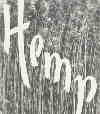
|
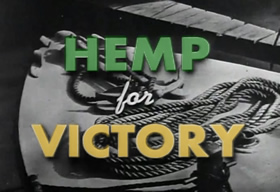 DURING THE SECOND WORLD WAR |

|
|---|
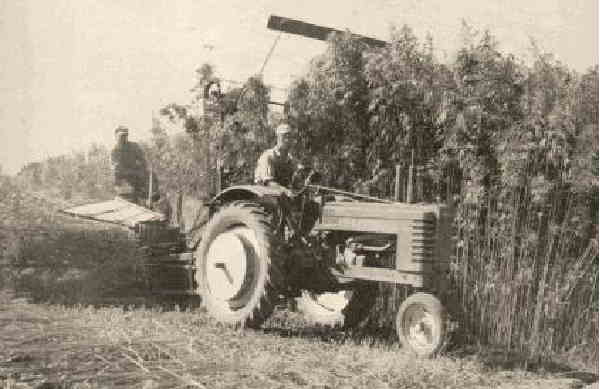
5.0 - AFTER THE WAR
--- WHAT BECAME OF THE INDUSTRY:
During the war we had tens-of-thousands of American farmers actively growing hemp for the war effort. Yet, needless to say, we don’t see tens-of-thousands of Industrial Hemp growers today. -- So what happend? What became of our nations Home Grown Hemp Industry after the war?
During the war there was a lot of talk of maintaining our H.G.H. (Home Grown Hemp) Industry long after the war. To quote one article:
CLAIMS HEMP TO BE PERMANENT POST WAR CROPYet as can be seen from the table below (per IRS statistics) within a few short years after the war our H.G.H. Industry had been all but eliminated.
. . . Hemp will be a permanent, post-war crop in the United States and Iowa will be the principal producing area in the opinion of Fred E. Butcher, Chicago, president of War Hemp Industries, Inc. a subsidiary of the commodity credit corporation.
“Iowa has the largest acreage suitable for hemp production," Mr. Butcher pointed out, and Iowa State college has already received a $70,000 federal research grant, the largest allowed any of the several state and private institutions studying the problem. . . . It is reasonable to believe . . [after the war] . . that it will take from three to five years after the war before the hemp industry could be re-established in the Philippines and Java. Before that time American ingenuity will have established the hemp industry firmly in this country, he believes. Many of the problems in connection with the growing of hemp in this country, such as the high labor cost, already are being solved, he pointed out. Turning of retted hemp by hand, principal objection raised by farmers asked to grow vital war crop, already has been eliminated, he believes, machines have been developed separately in Iowa, Illinois and Wisconsin which will do the job . . more . . -- MasonCityGlobeGazette1943-05-05p15
| STATE | 1938 | 1939 | 1940 | 1941 | 1942 | 1943 | 1944 | 1945 | 1946 | 1947 | 1948 | 1949 | 1950 | 1951 |
| Alabama | - | - | - | 1 | 2 | 1 | 1 | - | - | - | - | - | - | - |
| Calif. | - | - | - | - | - | - | - | - | 1 | - | - | - | 1 | - |
| Colorado | - | - | - | - | - | - | 2 | 2 | - | - | - | - | - | - |
| Delaware | - | - | - | - | - | - | - | - | - | - | - | 1 | 1 | - |
| Illinois | - | 1 | 2 | - | 1 | 3272 | 3331 | 934 | - | 1 | 1 | - | - | - |
| Indiana | - | - | 1 | 1 | - | 844 | 845 | - | - | - | - | - | - | - |
| Iowa | 2 | - | - | 2 | - | 4073 | 4083 | 986 | 1 | 1 | 1 | 1 | - | - |
| Kentucky | 154 | 36 | 108 | 321 | 8308 | 9200 | 15178 | 130 | 84 | 130 | 145 | 40 | 36 | 22 |
| Louisiana | - | - | - | 1 | 1 | 1 | 1 | 1 | - | - | - | - | - | - |
| Mass. | - | - | - | - | - | - | 2 | - | - | - | - | 3 | - | - |
| Michigan | - | - | - | - | - | - | - | - | - | - | - | 3 | - | - |
| Minnesota | 183 | - | - | - | 107 | 3619 | 3745 | 808 | 4 | 5 | - | - | - | - |
| Miss. | 1 | 1 | - | - | 2 | 1 | - | - | - | - | - | - | - | - |
| Missouri | - | - | - | 1 | 3 | - | 2 | - | - | - | - | - | - | 1 |
| Montana | - | - | 1 | 1 | - | - | - | - | - | - | - | - | - | - |
| Nebraska | - | - | - | - | - | - | - | - | 1 | 1 | 1 | 1 | 1 | 1 |
| Nevada | - | - | - | - | - | - | 1 | - | - | - | - | - | - | - |
| New York | - | - | - | 29 | - | 3 | 15 | 17 | 1 | 5 | 2 | - | - | 3 |
| N. Dakota | 2 | - | - | - | - | - | - | - | - | - | - | - | - | - |
| Ohio | - | - | - | - | 2 | 3 | - | - | - | 6 | - | - | - | - |
| S Carolina | - | - | - | - | 3 | 5 | 1 | - | - | - | - | - | - | - |
| Tennessee | - | - | - | - | 18 | 80 | 76 | - | - | - | - | - | - | 1 |
| Utah | - | - | - | - | - | - | - | - | - | 1 | - | - | - | - |
| Virginia | - | - | - | - | 2 | 1 | 1 | 1 | - | - | - | - | - | - |
| W.Virginia | - | - | - | - | - | - | - | - | - | 1 | 1 | - | - | - |
| Wisconsin | 111 | 191 | 171 | 400 | 600 | 3451 | 3676 | 1849 | 706 | 531 | 465 | 410 | 347 | 110 |
| Wyoming | - | - | - | 9 | 7 | - | - | - | - | - | - | - | - | - |
To be fair, there were a lot of factors involved that led to hemps demise after the war. For one, cheap cordage imports which had so adversely affected the Industry before the war were once again resumed after its end. In addition, recalling that during the war it was political (as well as military) expedience, NOT FREE MARKET FORCES that had set the price of Hemp. And as we have seen, that price, as an inducement to grow, had been set a tad-bit higher than what farmers would have normally been able to make otherwise. After the war, those subsidies were essentially cut off, meaning that post-war farmers now had to gage whether or not Hemp was their most profitable option.
However, be-that-as-it-may, the main reason for the shift away from Hemp-Growth can be summed up by the following newspaper article:
Wisconsin Rapids Daily Tribune (1945-05-05p8)Thus, it was Harry Anslinger’s Bureau of Narcotics who we once more have to thank for the situation we again find ourselves in. Simply put, the very same people who turned the switch (from Reefer Madness to Hemp For Victory) during the war, had now turned it back again.
Hemp Growers Protest Government Measure
“Washington -- (AP) -- Wisconsin hemp growers told a senate finance subcommittee Thursday the government is forcing them out of business.
It seems that the leaves and flowers of the hemp plant can be used to manufacture marijuana cigarettes. Recently the narcotics division of the treasury department ordered growers to remove the leaves and flowers before spending their product to the mills.
Matt Rens of Brandon, Wis., told the committee that such a process not only would injury the plant but would be so costly there would be no point in growing it. “
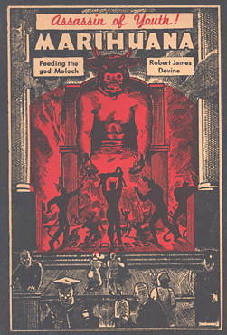
|
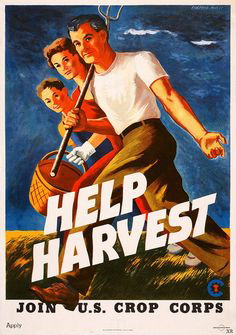 |
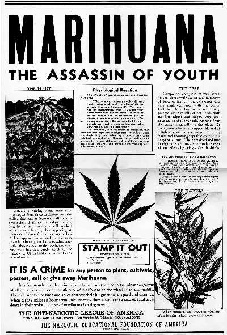 |
|---|
5.1 - FROM THIS TO THAT AND BACK AGAIN
YET NONE DARE CALL IT CONSPIRACY
(The following contains opinions, which may not represent all museum viewpoints)
QUESTION: How does one go from the Reefer Madness poster on the left to the "Hemp For Victory" campaign poster in the middle and then back again immediately after the war? How could such a thing be done and done almost overnight? It was almost as if an invisible hand had been reaching out, switching things on and off like a light bulb.
5.1.1 - AFTER THE WAR
THE END OF WAR-TIME SUBSIDIES:
It would be remiss on our part not to at least cover some of the somewhat mundane yet critical factors involving the post-war period. The most important of which involved federal wartime subsidies, which had been created as an inducement to get farmers to grow domestic hemp crops. Perhaps it would be best to go over some of the figures:
According to the Wall Street Journal (Jan 9, 1947p1), the pre-war price was around 5 cents a pound. While according to a 1943 article:
The participating farmers will receive a return of slightly more per acre than they would from corn, and will be paid from $30 to $50 a ton for hemp in the field. The harvest will be in late August and during September. -- Wall Street Journal (Jul 9, 1943 p1)This comes out to around 20 cents a pound. Or four times what they would have gotten before the war. HOWEVER, here it should be noted that “Before the War” meant the Great Depression and all prices were depressed. In addition, it should be noted that farmers were expected to pay (a very small fee) to rent out special Hemp harvesting machinery, etc. But no matter how one jimmies with the figures, the farmers, those who decided to grow Industrial Hemp during the war, economically speaking, made off well. Recalling that we are talking about 1943 dollars, according to one newspaper report:
MadisonCityGlobe-Gazette1944-01-27p16HOWEVER, once the war ended, so too ended the subsidies.
CROP OF HEMP NETS FARMER OVER $1,500
"The Franklin county hemp crop has been stacked, most of it outside the Hampton hemp mill. The gross income from it will be approximately $400,000.
Franklin county farmers have turned over 9,658 tons to the War Hemp Industries Inc. The hemp, according to Fred Stover, manager, graded as follows: No. 1, 31%: No; 2, 41%; No. 3, 20%; No. 4, 8%.
A record crop was grown on the H. F. Slee farm south of town operated by Arthur Haisch. On an 80-acre tract, nearly 32 tons of hemp all grading No.1 were grown. It grossed $210.44 an acre and netted $191.69 an acre. The total net check $1,533.52. "
5.1.2 - AFTER THE WAR
THE RESUMPTION OF CHEAP IMPORTS:
According to the Wall Street Journal (Jan 9, 1947p1):
“United Fruit's reluctance to exercise options it holds on the plantations is undoubtedly due to (the) belief hemp prices will slide back to pre-war levels of around 5 cents a pound once supply catches up with demand --- in a matter of three or four years. Higher labor costs in Latin America than in the Philippines would rule out the former area as an economic producer unless the Government offered to subsidize the hemp farms permanently.” -- The Wall Street Journal (Jan. 9, 1947 p1)In fact, even before the war’s end it was already becoming obvious that cheap imports were going to begin flooding the US again:
“. . the government had started from scratch to create a hemp industry in this country when it appeared that normal sources of rope materials had been cut off by war. Abatement of the submarine menace in the Caribbean and the clearing of the Mediterranean has eased the shortage by permitting imports. . ” -- The Chicago Daily Tribune (1944-01-20 p23)So strictly from a business standpoint, it took no crystal ball to see that cheap imports, which had brought so much woe to our pre-war Home Grown Hemp Industry in the first place, were now about to stage a comeback.
5.1.3 - AFTER THE WAR
ANSLINGER’S BUREAU REAPPEARS
During the war, one important yet almost always overlooked factor that allowed tens-of-thousands of American farmers to grow Hemp for the war effort was (what can only be termed) the effective shut-down of the Reefer Madness hysteria campaign. In effect, the propaganda machine (aka Reefer Madness) not only STOPPED, it literally changed course. Now Anslinger’s Bureau of Narcotics, instead of harassing, was actively encouraging its growth. The following provides a good example of the change:
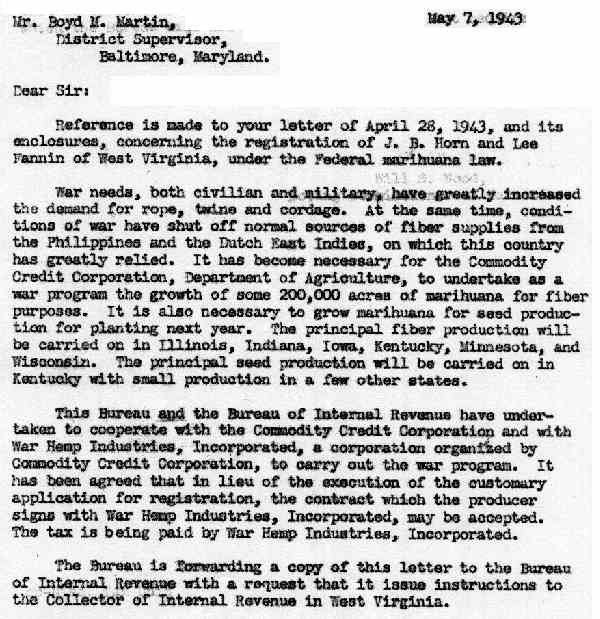
May 1, 1943QUESTION: Would the pre-War Bureau of Narcotics have ever written anything like that? NO WAY JOSE! But this was a situation that wouldn’t last very long. It must be remembered that when we entered the war (the tail end of ‘41), no one knew with any certainty how long the war was going to last, nor (given one Axis victory after another) even who was going to win it. Was the war going to last ten-years, twenty-years? During those early days, no one knew. However by the middle of 1944, the path was already very predictable. We were going to win and that the war was going to be over in another two to three years. Thus a time for Anslinger’s Bureau to start rethinking the future.
Mr. Boyd M. Martin,
District Supervisor,
Baltimore, Maryland.
Dear Sir:
Reference is made to your letter of April 28, 1943,, and its enclosures, concerning the registration of J. B. Horn and Lee Join of West Virginia, under the Federal marihuana law.
War needs, both civilian and military, have greatly increased the demand for rope, twine and cordage. At the same time, conditions of war have shut off normal sources of fiber supplies from the Philippines and the Dutch East Indies, on which this country has greatly relied. It has become necessary for the Commodity Credit Corporation, Department of Agriculture, to undertake as a war program the growth of 200,000 acres of marihuana for fiber purposes. It is also necessary to grow marihuana for seed production for seed planting next year. The principal fiber production will be carried on in Illinois, Indiana, Iowa, Kentucky, Minnesota and Wisconsin. The principal seed production will be carried out in Kentucky with small production in a few other states.
This Bureau and the Bureau of Internal Revenue have undertaken to cooperate with the Commodity Credit Corporation and with War Hemp Industries, Incorporated, a corporation organized by Commodity Credit Corporation, to carry out the war program. It has been agreed that in lieu of the execution of the customary application for registration, the contract which the producer signs with War Hemp Industries, Incorporated, may be accepted. The tax is being paid by War Hemp Industries, Incorporated.
The Bureau is forwarding a copy of this letter to the Bureau of Internal Revenue with a request that it issue instructions to the Collector of Internal Revenue is West Virginia.
As you know, the Federal marihuana law does not require that a person be “lawfully entitled” to obtain registration thereunder. It is not necessary that these applications be referred to you for approval.
The matter of compliance with the State laws is being taken care of by Commodity Credit Corporation and is a matter with which the Bureau will not concern itself at this time.
Very truly yours,
Will S. Wood,
Acting Commissioner of Narcotics.
Even before the war was over the campaign to demonize marihuana was back on again. A factor that explains just why America’s Home Grown Hemp Industry flourished so much during the war, but then quickly died off thereafter. The following newspaper article pretty much sums up what happened:
Wisconsin Rapids Daily Tribune (1945-05-05p8)
Hemp Growers Protest Government Measure
Wisconsin hemp growers told a Senate finance subcommittee Thursday the government is forcing them out of business.
It seems that the leaves and flowers of the hemp plant can be used to manufacture marijuana cigarettes. Recently the narcotics division of the treasury department ordered growers to remove the leaves and flowers before spending their product to the mills.
Matt Rens of Brandon, Wis., told the committee that such a process not only would injure the plant but would be so costly there would be no point in growing it.“
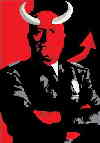 |
AFTER THE WAR AN INDUSTRY DESTROYED SATAN STRUGGLES TO RECOVER More about Anslingers attempt to destroy all post war Hemp growth. |
Thus, it was Anslinger’s Bureau of Narcotics, more than anyone else who we once more have to thank for the situation we once more find ourselves in. Simply put, they very same people who turned the Reefer Madness to Hemp For Victory switch during the war one way, now turned it back on the other way - again.
5.2 - YET NONE DARE CALL IT CONSPIRACY
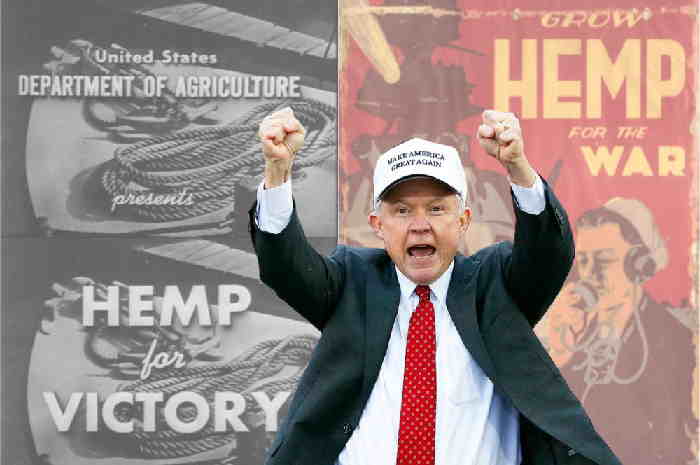
WAS THERE A CONSPIRACY?
(The following contains personal opinions, which may not represent all museum viewpoints)
By this point most people concede that Jack Herer’s [1] original conspiracy theory as described in his now classic book “The Emperor Wears No clothes” (ah, how shall we say it) had its errors. However because of the late Jack Herer’s persona (he was a living legend throughout the 80’s and 90’s) his theory although disproven, is still popular to this day. It basically goes something like this:
In the late 1930’s the Dupont corporation patented a new type of petrochemical process that would allow plastics such as nylon and rayon to be made cheaply out of oil based substances. These would then be used to make synthetic forms of ropes, cords, fibers, cloths, etc., - the same things that Hemp was being used for. Thus, if hemp were outlawed (the competition taken out of the picture), they would stand to make a lot of $$$$But the theory (as a theory per say) has a lot of holes in it that have now been recognized as such:
Next enters Andrew Mellon, a rich banker who (through the Mellon bank) could finance the Dupont venture and also make a lot of many. Next enters one William Randolph Hearst, a newspaper magnet whose company also happened to own vast tracks of timberlands. And thus, according the theory, was also in a position to make lots and lots of money; -- But only if Hemp (which could be used to make paper products) was outlawed.
Last of all enters the Harry Anslinger-Mellon connection. Mellon, who happened to be Secretary of the Treasury at the time, appointed Harry Anslinger (who just happened to be married to his wife’s niece) as head of the newly created Bureau of Narcotics, with instructions to start demonizing the Hemp plant. At the Same time Hearst’s newspaper chain was also starting in on the campaign, . . . and thus was born the Reefer Madness campaign. . .etc.”
First, Anslinger’s wife Martha was NOT related to the Melon family in anyway, at least none that we’ve been able to find out about. This (very minor) mistaken belief probably came from Ratso Salaman’s book “Reefer Madness,” a classic from the 1980’s, and in all probability was an honest mistake. But whatever the case, it appears that Anslinger simply had no family ties to the Melon Family in any way.
Next, it appears that the William Randolph Hearst connection is also in great doubt. Granted Hearst was a yellow journalist and glorifed as an anti-drug crusader. However, a quick survey of his papers shows that he did no less, nor no more, than other newspaper groups of his time. And as for large tracks of pulp-paper lands; Quoting Steven Wishnia:
“According to W.A. Swanberg's extensive biography of William Randoff Hearst . . the Hearst chain was actually the nation's largest purchaser of newsprint -- -- and when the price rose from $40 a ton to over $50 in the late 1930s, he fell so deep in debt to Canadian paper producers and banks that he had to sell his prized art collection to avert foreclosure. "It therefore seems that it would have been in Hearst's interest to promote cheap hemp paper substitutes, had that been a viable alternative."Last of all, as for Dupont specifically targeting the Industrial Hemp industry for demise, this ignores the fact that the Dupont Co. patent was dated 1937, yet the Hysteria campaign had started back in the 1920’s. Also, as discussed in previous sections, the demise of our Home Grown Hemp industry had already taken place. Simply put, our farmers couldn’t compete with the cheap imports, and this was especially true after the annexation of the Philippines. Additionally, outlawing the Hemp plant here in the US would have done nothing about the imports that we were using in the first place.
So the conspiracy (as described by Jack Herer) made no economic sense. Even if ALL hemp, both domestically grown as well as imported, were to have been outlawed. It still left many, many other forms of raw cordage materials (jute, Manila Hemp, sesal etc.), so outlaw Industrial Hemp for what purpose and to what end?
However, be that as it may, we should all be thankful to Jack for being the first one to bring out such a point and for getting us all thinking about the possibility that a conspiracy did indeed occur. Because at this point, it appears that one very much did occur. So returning back to our open question, was the creation of the anti-Medical Marihuana laws a natural occurrence or the act of an organized conspiracy?
At least in one person’s opinion, without a doubt, the answer is a resounding YES! And at least one level of proof of that lies in how the organs of propaganda (especially Anslinger’s Bureau of Narcotics) acted, before, during and after the war. Simply ask yourself, how could it have been accomplished by anyone, other than an organized group of very powerful, very well connected (we presume) elderly men, meeting in a smoke filled room somewhere to dictate the future course of our country.
Now, in all fairness, there are many out there that simply refuse to believe in such things. Their arguments usually run something like:
- That there is no actual written proof of such (smoke-filled-room) meetings. As if the conspirators were actually going to hire a secretary to take down minutes of what was being said.
- That if so, somewhere along to road, some law enforcement agency would have stumbled, bumbled or fumbled into what was going on, thus putting an end to their evil plans. As if the very purpose of this kind of conspiracy wasn't first and foremost to have the right kind of laws passed. That way the very law enforcement agencies that would have been there to stop them would thereafter be doing they’re bidding.
- That surely one of them via, malice, treachery, betrayal or just wanting to get something off of their chest would have coughed up the truth on his death bad Which by the way is a very good point, and truth be told, many probably had. Perhaps a good modern-day example was provided by John Ehrlichman who even went so far as to state:
"The Nixon campaign in 1968, and the Nixon White House after that, had two enemies: the antiwar left and black people. You understand what I'm saying? We knew we couldn't make it illegal to be either against the war or blacks, but by getting the public to associate the hippies with marijuana and blacks with heroin, and then criminalizing both heavily, we could disrupt those communities. We could arrest their leaders, raid their homes, break up their meetings, and vilify them night after night on the evening news. DID WE KNOW WE WERE LYING ABOUT THE DRUGS? OF COURSE WE DID." ---John Ehrlichman President Richard Nixon’s adviser on domestic affairs
Yet note how little became of such statements. And even if anyone did question them, for the most part the conspirators could claim that they were simply good citizens who got together as a civic group to talk about politics. Nothing wrong with that is there? - That no matter how well connected the conspirators were, they was simply no way in which any group of individuals, no matter how powerful, how well connected they where, could have controlled each and every event that occurred throughout the conspiracy. And there is truth in that, however this logic ignores the obvious; ---They didn’t need too. The following (taken from one of our pamphlets) provides a good example:
The Reefer Madness Era

===== The Conspiracy ====
CONTROL OF THE NEWSPAPER MEDIA
QUESTION: How could any group of people, no matter how wealthy or well connected possibly take control of the whole of the newspaper industry? In a society which values its 'freedom of the press' so much, this would seem a most formidable if not impossible task today, and given the much, much larger number of newspapers, with some major cities having as many as sixteen of them back in the 1930's, even more so. Unfortunately the answer to the question of HOW was “VERY EASILY."
Anyone who has does even a quick scan through some of the newspaper articles our museum has collected from that era, can't help but notice two letters -- (A.P.) such as in; "The Associated Press." It seems that there was no need to go to each and every newspaper editor/publisher and attempt to co-op them into the conspiracy. All one needed to do was control a few of the national news sources that in turn were relied upon by local newspapers to provide them with their national news coverage.
It was the Associated Press that kept feeding a constant stream of boring, yet negative articles (everything from statistics on marihuana arrests, to a short article on a public school teacher who was going to speak on the subject at some local civics group somewhere). The purpose of these articles seems to be --- Not to shock, but to keep the subject in a negative light and constantly before the public eye. Additionally it was also noticed that many of the worst hysteria articles were those detailing some gruesome axe murder somewhere and were not locally written articles, but appeared in the Sunday supplements. Newspaper Sunday supplements that were written and controlled by national, not local interests.
Of course, this is not to say that the DEA (then known as the Bureau of Narcotics), didn’t do everything possible to encourage local Reefer Madness articles and provided as much technical and logistical support as possible. And then unfortunately, there were too many unscrupulous reporters who had no regard for the truth.
While the name may be well known to us today, the New York Times (Pulitzer prize winning) Moscow correspondent, Walter Duranty, who in 1933 at the height of Stalin's organized famine in the Ukraine which killed millions, wrote articulate denials on the subject stating that; "Any Report of a famine in Russia is today an exaggeration or malignant propaganda". But how many of us recognize the name of Julius Klein, who in 1935 wrote a series of Reefer Madness articles for the St. Louis State times? That he knew he was lying is not in question. In one of the articles he misquotes a military study on marihuana so skillfully that there is no question that he had complete knowledge of the truth. Or for that matter, there were the number of other newspaper reporters who simply went with the flow; regardless of how many lies they had to tell.
At a later time (long after the campaign), even Harry Anslinger would state how irresponsible the press had been. Sighting the following article as a good example:"One reporter on a Southwestern newspaper pointed out that there was a suspicion of marihuana use in a case. Next day the headlines read, 'Gang of Marihuana Crazed Hoodlums Leave Bloody Trail.' Questioned, the scribe had nothing tangible on the marihuana angle and claimed that the heading had been composed in the editorial room. "
Thus it appears that even Anslinger himself was taken aback by how easily it had been to manipulate the news media.
And unfortunately, things pretty much remain the same today. And granted, most of us today are only a few paychecks away from total financial destitution meaning you do what you have to do to keep your job. Still, one would think that the news media (whether, TV, radio, or print), would have some higher moral standards, but no. Throughout Oklahoma, many incidents of injustice, what are obviously medical marihuana arrests take place on an almost daily basis. Yet, despite full knowledge of the truth, our news media over here, either cover the story as if it was a drug deal gone bad or simple ignores it altogether.

|
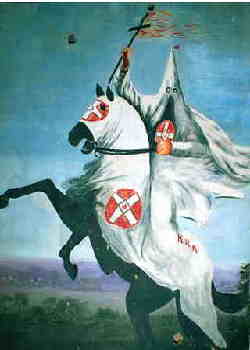 |
 |
|---|
THE MIND OF CONSPIRACY:
While our museum has been able to document one 1930’s governmental official after another lying through their teeth about the effects of Marihuana, [acting both individually as well as in groups, by itself established conspiracy], for our purposes here, the real test of the original question lies in yet another question. One put forward to anyone who does not believe:
HOW do you go from a pre-war propaganda campaign proclaiming Hemp as the “Assassin of Youth”, the “Killer Drug”, to a war-time propaganda campaign virtually pleading with farmers to grow this very same plant. Then, just as fast (after the war), go back to the same propaganda that was being spilled out before the war? How could such a thing be done, and done almost overnight? Almost as if an invisible hand had been reaching out, a hand so powerful that it could switch things on and off, almost as ONE WOULD a light bulb switch.
The answer is obvious, ---you can’t. Unless that is, there really was an invisible hand involved. Simply put, logic and reason dictate that public perceptions simply don’t change overnight. If you truly believed what the propaganda had been telling you about Medical Marijuana as the Weed of Madness; that its use led its users into committing bestial crimes, then the last thing on earth anyone would want was to see it growing in the field next to you. After all, what if your son starting using it, what if he went out and killed someone under its influence? Or worse yet, what if your daughter were to jump out of a fifth story window? Thus it would seem that only Axis saboteurs, or their fellow travelers, would ever support such a thing.
YET, SOMEHOW, despite years and years of governmental propaganda demonizing the plant, this is exactly what happened. A situation which begs yet another question: HOW WAS THIS DONE? How did they turn the clock back on one of the greatest propaganda campaigns (or snow jobs) of the century? The answer, very carefully and with a lot of lies.
By chronological measurements, the “Hemp For Victory” campaign can be defined as having begun in February of 1942, when the first newspaper accounts started talking about why we now needed to grow Industrial Hemp here. One can only hypothesize on the events leading to one of the greatest flip-flops in the history of propaganda. One which probably ran something like this:
- Even before the fall of the Philippines, some desk clerk at one of the newly formed governmental war materials boards must have looked at the data, and then hit the panic button.
- Soon the higher-up’s at that wartime materials board must have looked at the same data and also started to panic. Especially after they figured out that America (courtesy of the Reefer Madness campaign) didn’t have a Home Grown Cordage Industry of it own. And now (thanks to the Axis powers) we were out of luck on any imports.
- Probably, within weeks thereafter, even the high level political types must have also come to the same conclusion. But what to do? The only possible cordage material we could realistically grow here within North America was Hemp. A plant that we were still demonizing at the time.
- The solution was simple, hypothetically speaking, as Mr. Roosevelt might have said it;
--- Mr. Reefer Madness is going to have to give way to Mr. Win The War. - In all probability, Anslinger himself was probably (very discreetly) told about the situation by one of his fellow conspirators long before he got the official word from Washington. ---- Now at this point, had Anslinger himself really believed in what he had been saying all those years, he probably would have balked at the very suggestion of such a thing. After all, how could a horrible narcotic like Marihuana possibly help rather than hurt the war effort? What would happen if soldiers, factory war workers, etc., were to start using it? So one would expect him to have used his influence to do what he could to stop the industry's rebirth, claiming it was all an Axis plot to weaken America from within, etc. But no, in all probablilty, after being told the facts about the wartime situation, he probably just winked at his fellow conspirators and that was that. The Bureau of Narcotics had just done a 180-degree turn. And Anslinger would see to it that it stayed that way for the remainder of the war.
- Not only did the Bureau tone down its Reefer Madness campaign (something they had already been doing since the passage of the Marihuana Tax Act), but now it bordered on (what must have been to the Bureau) an out and out reverse censorship campaign. For example, examine the following incident:
-
WOMAN STABBED, CASTRATION
Name: Alvin Arnesen/Georgia Castenada (Victim) - Date: Nov. 27, 1944 - Location: Los Angeles
What the Narc’s were claiming
1944 - A. Arnesen - M - 39 - Murdered Ga. Castenada, 29; mutilated her hips and head with razor blades, then castrated self; had been smoking marihuana for an hour before attack. - Arrested, hospital, jail. -- 6th conference report - INEOA 1965
And without a doubt, Anslinger et al, used whatever influence his bureau had to muffle the press and other sources of public information. The number of Marihuana (Marijuana) newspaper mentions drop substantially during this time period. In some areas, had it not been for some high profile cases such as the Gene Krupa arrest, the subject might have disappeared altogether.
However, be that as it may, it appears that the conspirators, even during wartime conditions, no matter how powerful, couldn’t control all the media. For example, whoever controlled the Green Hornet franchise simply didn’t get the message.
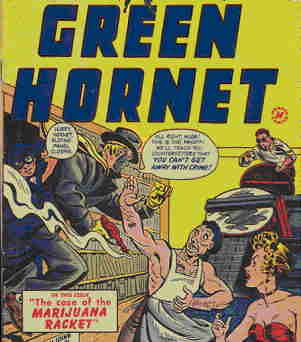
|
From a 1949 Comic Book story
GREEN HORNET June 20, 1944 -- Dope Versus The War Effort An Old Time Radio program first broadcast in 1944 or well within the Hemp For Victory era. The story line deals with a ring of Axis saboteurs who go around selling Marihuana to workers at a war plant. At first, their sabotage plot seems to work as workers (under the influence of marihuana) go nuts and start doing reefer madness type stuff. But don’t worry, the Green Hornet soon puts a stop to all this. [This programs makes for fun listening and is available for free download via the internet] |
|---|
However, in general Anslinger (et al) were able to keep the news/entertainment media well in line.
5.3 – POST WAR AMERICA
BACK TO BUSINESS AS USUAL:
Retracing what has already been said:
- During the war, tens of thousands of American farmers took part in the Second World War’s “Hemp For Victory” program. This was done, not as a change of heart on the part of the narc's, but solely by necessity brought about by war needs. Industrial Hemp cordage was a vital war raw material -- End of Story.
- It appears that nether Anslinger nor his bureau thought of the program as lasting longer than the duration of the war. However, immediately thereafter (in fact even before the war ended) there was talk of maintaining our domestic H.G.H. (Home Grown Hemp) industry on a permanent basis. And with good reason. Newly designed farm equipment had finally solved the labor intensity issues that had made cheap imports so attractive in the first place. Now for the first time (in a long, long time) American farmers could complete with third world imports.
Even governmental publications at the time were touting the glories of a newly revived H.G.H. industry. Examples, obtained via a quick scan of the OCLC (Inter-Load Library System):WHAT ABOUT GROWING HEMP? Author: Albert Hazen Wright; University of Wisconsin. Extension Service. Publisher: Madison, Wis. : Extension Service, College of Agriculture, University of Wisconsin, 1942. OCLC Number: 320268294 - Description: 8 pages : illustrations ; 23 cm.
Thus, with even various State governments backing it, there was some real hope that America’s H.G.H. industry was indeed going to stage a full comeback.
HEMP (Cannabis sativa; a war crop Author: Guy W Sackett; Merrill H Hobbs; Mason & Hanger Company. Publisher: [New York] 1942. -- OCLC Number: 43066146 Description: 25 leaves illustrations 28 cm Responsibility: Prepared in the Engineering dept. of Mason & Hanger co. of New York city, by Guy W. Sackett, vice president, and Merrill H. Hobbs, chief architect.
HEMP PRODUCTION EXPERIMENTS : cultural practices and soil requirements Author: C P Wilsie; C A Black; Andrew R Aandahl Publisher: Ames, Iowa : Agricultural Experiment Station, Agricultural Extension Service, Iowa State College, 1944.
Series: Bulletin (Iowa Agricultural Experiment Station), P63.
THE RETTING OF HEMP I, Field retting of hemp in Iowa Author: W H Fuller; A G Norman; C P Wilsie Publisher: Ames, Iowa : Agricultural Experiment Station, Iowa State College of Agriculture and Mechanic Arts, 1946. pages 834-891 : illustrations, charts, map ; 23 cm.
Series: Research bulletin (Iowa Agricultural Experiment Station), 342. Edition/Format: Print book : State or province government publication : OCLC Number: 17515376
THE RETTING OF HEMP II, Controlled retting of hemp Author: W H Fuller; A G Norman Publisher: Ames, Iowa : Agricultural Experiment Station, Iowa State College of Agriculture and Mechanic Arts, 1946. pages 896-924 : illustrations, charts ; 23 cm.
Series: Research bulletin (Iowa Agricultural Experiment Station), 343. Edition/Format: Print book : State or province government publication : OCLC Number: 17515385
THE RETTING OF HEMP III, Biochemical changes accompanying retting of hemp Author: W H Fuller; A G Norman Publisher: Ames, Iowa : Agricultural Experiment Station, Iowa State College of Agriculture and Mechanic Arts, 1946. pages 928-944 : charts ; 23 cm.
Series: Research bulletin (Iowa Agricultural Experiment Station), 344. Edition/Format: Print book : State or province government publication : OCLC Number: 17515393
HEMP: a war crop for Iowa Author: C P Wilsie; E S Dyas; A G Norman Publisher: Ames, Iowa : Agricultural Experiment Station, Agricultural Extension Service, Iowa State College, 1942. pages 588-600 : illustrations, map ; 23 cm.
Series: Bulletin (Iowa Agricultural Experiment Station), P49. OCLC Number: 17008510
THE COST OF PRODUCING HEMP IN ILLINOIS IN 1943: Author: R H Wilcox; University of Illinois at Urbana-Champaign. Agricultural Experiment Station. Publisher: Urbana, Ill. : Department of Agricultural Economics, Agricultural Experiment Station, College of Agriculture, 1944. 4 pages : illustrations ; 30 cm OCLC Number: 694191486
HEMP: an Illinois war crop Author: J C Hackleman; W E Domingo Publisher: Urbana, Ill. : University of Illinois, College of Agriculture, Extension Service in Agriculture and Home Economics, 1943. 7 pages : illustrations ; 23 cm.
Series: Circular (University of Illinois (Urbana-Champaign campus). Extension Service in Agriculture and Home Economics), 547. OCLC Number: 17304735 - However, within a few short years (see M.T.A. table above), despite a willingness on their part, those tens-of-thousands of hemp farmers had been reduced to a trickle. Something, which returns us back to our original question; WHY? And maybe the even more important question; HOW? In even trying to address those two questions, it may be best to recap what has already been said in a more mechanical, less emotional fashion:
- From a governmental standpoint, soon after (and in some cases even before) the war ended, All wartime agricultural subsides for hemp were dropped.
- - Meaning that farmers were now no long guaranteed either a set price (guaranteeing a good profit), nor a guaranteed buyer for their crop.
- - Nor were farmers going to be guaranteed a buyer for their crops as the U.S. Government was no longer buying.
- - Additionally, farmers were no long going to be allowed to rent out governmentally owned specialized farming equipment as they had previously done during the war.
- Next, even before the war’s end the Federal government, believing that it had enough cordage materials for the duration of the war, began closing down and then selling off (via the Reconstruction Finance Corporation) it’s 72-recently constructed wartime hemp processing mills along with their equipment.
While no evidence of any conspiratorial nature exists, it is a fact that these newly built hemp mills were sold off to just about anyone WHO DIDN’T want to continue using the plant as an ongoing hemp operation. But instead solely to those who wanted to convert them to other uses. Which in turn created a problem for existing hemp farmers. Recall that Hemp stalks are rather heavy as well as bulky, not having a hemp processing plant near by means increased shipping costs.
However, as farmers had long ago learned to create commercial co-ops capable of building their own processing mills, the sales of the government owned mills were not therefore of and by themselves a major deal breaker. Even the specialized farm equipment that the farmers had rented during the war could also have been continued via the use of rental co-op owned equipment. - The end of war also meant the return of cheap imports. This factor cannot be underestimated, according to the Wall Street Journal (Jan 9, 1947p1):
“United Fruit's reluctance to exercise options it holds on the plantations is undoubtedly due to belief hemp prices will slide back to pre-war levels of around 5 cents a pound once supply catches up with demand---in a matter of three or four years. Higher labor costs in Latin America than in the Philippines would rule out the former area as an economic producer unless the Government offered to subsidize the hemp farms permanently.”
And needless to say, there were NOT ONLY, NOT going to be any more hemp subsidies but America’s farmers as well as its industrial workers, would soon find themselves stabbed in the back by their own government at home.
PERSONAL OPINIONS
Before the war, American politicians worked to protect American workers, to build up America’s economy, and granted some of the things they did were counterproductive, still their goal was to look after American interests. After the war however it appears that things changed and changed, for the worst. While American industries still faced one foreign trade barrier after another, our government pretty much opened up all our markets to just about any foreign countries. . No wonder we’ve lost so many industrial jobs. But that is nether here nor there. What is important to us here is that we specifically gave the newly independent nation of the Philippines continued duty free export rights for a number of years. This meant that our farmers were going to have to compete with cheap Manila hemp products again, just like they did before the war.
BUT that of and by itself was also not a major deal breaker, as modern farming equipment had already been developed to reduce much of the labor intensive sections of the industry, so it was still possible to continue with the industry here.
All were factors which of-and-by-themselves were no major impediment. Just about all farmers at that time had to deal with the same working conditions. Thus it had long been expected that after the war the subsidies would all end.
THEN CAME THE HARASSMENT FROM ANSLINGER'S BUREAU OF NARCOTICS:
As noted previously, none of the technical or mechanical factors associated with hemp production, either individually or all put together, were real obstacles to hemp growth. However, there was one element that could not be overcome, and that was the harassment from Anslinger's Federal Bureau of Narcotics. And as can be seen from the date of this newspaper article this began to occur even before the war.
Wisconsin Rapids Daily Tribune (1945-05-05p8)And while in this case (this one time), there was a happy ending; -- see
Hemp Growers Protest Government Measure
“Wisconsin hemp growers told a senate finance subcommittee Thursday the government is forcing them out of business. It seems that the leaves and flowers of the hemp plant can be used to manufacture marijuana cigarettes. Recently the narcotics division of the treasury department ordered growers to remove the leaves and flowers before sending their product to the mills. Matt Rens of Brandon, Wis., told the committee that such a process not only would injury the plant but would be so costly there would be no point in growing it. “
http://www.ReeferMadnessMuseum.org/IndustrialHemp/HempForVictoryPage06SatanStruggles.htm
If there was one thing Harry Anslinger’s bureau was good at (other than lying) it was interpreting rules and regulations so as to fit their agenda. Now with the war almost won, there was no longer any need for an American H.G.H. industry, and Anslinger was determined to see to it that it didn’t occur. And for good or for bad, he and his fellow conspirators had the weapons to do just that.
[NOTE: While we are not able to fully document the following allegations, it is obvious that given the character of Harry J. Anslinger, there is no question that he would have taken full advantage of the situation to accomplish his goals.]
-- DENIAL, PERMITS TO GROW MARIHUANA:
The Marihuana Tax Act, required all growers to register with the Federal Government and thereafter pay a special related tax. But all that assumes that the permit was issued in the first place.
-- DELAY, PERMITS TO GROW MARIHUANA:
What would happen if a permit to grow Marihuana was issued, but just not on time? Recalling that planting and sowing seeds weather-wise, can ONLY been done at certain times. One can only imagine what would happen to an entire season's crops if a needed permit were not issued on time.
-- HARASSMENT, SEED WHOLESALE ESTABLISHMENT:
Here the idea is simple, because most all hemp crops would be grown for stalk as oppose to seed. This of and by itself creates a situation where farmers must buy seed on an almost season-by-season basis. Thus the problem, what if you couldn't readily obtain seed or only able to do so at an extremely unreasonable price?
-- THE RETURN OF REEFER MADNESS:
Then came the rebirth of the Reefer Madness campaign, and while (in terms of hysteria) a mere shadow of what it used to be before the war. Still, it had the same intimidating effect as before. Marihuana = Dope, and anyone who had anything to do with it was a doper; --- end of story.
-- THE NEVER ENDING HARASSMENT:
AND if that wasn't enough, there was always the "Never Ending harassment" which narcotics officials seem to love to perpetrate. Simply put, you could always be accused of being a drug dealer at any time, no matter what. EXAMPLE: Here in Norman, Okla., we have some pretty sick people running around enforcing what they call "Drug paraphernalia laws". The problem with them is that they seem to think that everything is drug paraphernalia. So much so that the local merchants are in such a state of fear that if the narc's send them a letter telling them to remove this or that product from their shelves they just do it, no questions asked. Those that don't are arrested on some of the most trumped up charges one can imagine. And granted they can go to court, and after spending over $50,000 dollars in defense costs, be found not guilty. But to what end? Why sit in jail? Why have to spend a year or two in a courtroom? why risk so much in time and energy, just to buck the system?
Obviously, most of us will just play along and try to get by as best we can. And unfortunately, this was the same situation faced by farmers soon after the war. Only in a very few states where there enough of them to actually group together (for communal support) and buck the system. But even there, as the data shows, even these farmers slowly started to switch to other crops.
And so there is the real and ONLY reason why Home Grown Hemp production all but ceased in this country after the war. Simply put, one man, Harry Anslinger, Killed it.
POSTSCRIPT: (Personal Opinions)
– quote attributed to Senator Hiram W Johnson
If memory serves me well, sometime toward the tail end of the hippie era, I recall reading an article dealing with America’s hemp farmers during the war. One that even at that time (America’s hemp industry, and hemp’s industrial uses was at this point a long forgotten memory), I couldn’t help but notice that something was very odd about the article. Why did it have so little to say about the actual hemp (now known as the Hemp For Victory) program itself? Instead, it dealt almost exclusively with County Sheriffs who were going around preventing trespassers from getting anywhere near those old WW2 hemp mills. One Sheriff was even quoted as saying that he was taking steps to prevent the hippies from even knowing where the old mills had been located. . . .
It wouldn’t be until some fifteen years later that Jack Herer’s book, “The Emperor Wears No Cloths” came out (self-published), that the general public would once again learn about our true uncensored history. If the first casualty when war comes is truth, then in the words of cartoon character Pogo Possum, “We have met the enemy and he is us.”
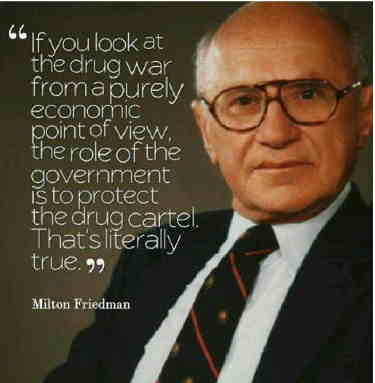
|
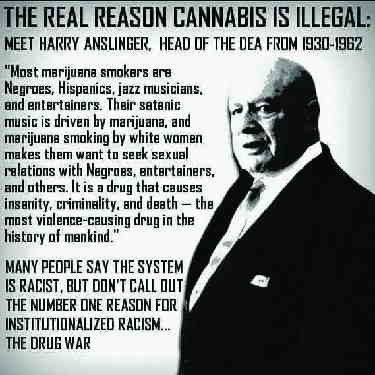 |
|---|
===========
FOOTNOTES:
[1]- The late Jack Herer was the author of “The electric Emperor” (such as in the four year old by who said the emperor had no cloths), a classic book dealing with Industrial Hemp, governmental lies, and the forces that lead to the creation of the anti-Medical marihuana laws. He was the first to bring out the possibility that there was an organized conspiracy which brought about the anti-Medical Cannabis laws.
WANT TO KNOW MORE:
=====================
Due to space / download time considerations, only selected materials are displayed. If you would like to obtain more information, feel free to contact the museum. All our material is available (at cost) on CD-Rom format.
CONTACT PAGE
 BACK TO Sec. IV HEMP DURING THE WAR |
 |
 BACK TO MAIN HEMP FOR VICTORY PAGE |